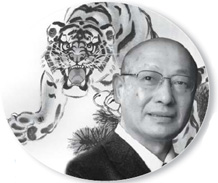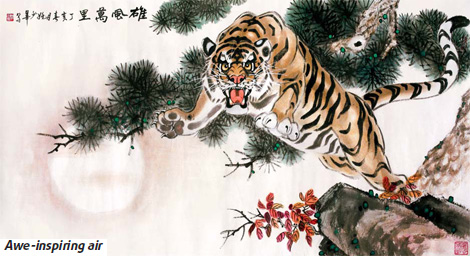Sketching tiger, hidden meaning
Yao Shaohua was born in Beijing in 1942 and studied under Wang Jinglu, one of the most renowned artists of his generation. From him, the young Yao learned the skills necessary for his exquisite depictions of landscapes, flowers and birds. Later, he graduated to become a student of another grand master - Hu Shuang'an. It was during his apprenticeship to Hu that Yao began to develop his distinct tiger motif that was to characterize many of his mature works.
Mastering many of the skills of his two noble forebears, Yao began to concentrate on developing his own style. This style came to be pervasive in his later work and his singular representation of the many postures and expressions of the tigers he committed to canvas.
Sometimes he sparingly uses only a few lines to bring the tigers to life, yet the essence of his works goes well beyond his scant outlines. To many, his paintings represent the veritable apogee of Chinese freehand brushwork.
Speaking of his own oeuvre, Yao says: "What is reflected in Chinese brush painting is not confined to what we see with our eyes, such as the shape and the outline. It represents the very essence of things."
According to Yao, to gain a clearer understanding of the artistic milieu, it is necessary to take the opportunity to appreciate Chinese paintings alongside their creators and come to understand their way of realizing their unique vision.
Chinese brush painting is a unique tradition, which has existed for thousands of years, with many of its basic tenets remaining unchanged. The beauty of this classic style lies in 'shi' and 'xu'. Shi is any element that can be seen, such as the structural composition, use of space, method of expression, and the technical use of the brush. Xu refers to something more subliminal within the painting, notably its theme and artistic content. The combination of both is a unique feature of Chinese brush painting.
The invention of paper and the brush pen later encouraged the rise of another art form: painting. Today, it is called Chinese brush painting, so as to distinguish it from its Western oil painting counterpart.
Other than as a historical record, the essential intent of Chinese brush painting is to deliver a distinct message. The subject of these works can be derived from anything natural, but the aim is always to present the emergence of life.
Due to their uniqueness and boundless artistic value, many of Yao's works are now housed in the Zhongnanhai compound, one of the galleries of the Great Hall of the People.
As his fame has grown, Yao has been invited to take part in a series of high-profile exhibitions and forums. He has also published a number of books regarding his own works and artistic philosophy. To date, his books include "Chinese Painting: Techniques for Painting Animals" and "the Yao Shaohua Special".
Yao's works, especially his paintings of tigers, have won him a number of awards, including gold, silver and bronze trophies, as well as several commendations.
Yao pays strict attention to detail within his works. He will often spend many days, even months, perfecting certain techniques necessary to commit his imagination to the canvas.
He is dedicated to self-improvement - not only in his artistic endeavors, but also in the areas of history, literature and Chinese calligraphy. He places great emphasis on the necessity of painting appropriate subjects and using the correct style for the success of any aspiring Chinese painter.
Yao says: "A successful artist is good at choosing a suitable subject and then using his own artistic language to enhance it."
Unlike Western painters who prop their canvases on easels and stand opposite them, classical Chinese scholars preferred to keep the tip of their brush pen vertical to the paper, with their arms held above the desktop. This ensured that they could write smoothly, adjust the width of their characters and maximize the variety of their calligraphy. For adherents to this tradition, there are no limitations in the size of the brush pen. It depends solely on the painter's individual preference and the content of the painting.
In the year 105 AD, paper was invented by Tsai Lun, a eunuch in the Eastern Han Dynasty (AD 25-220). As it was more convenient and lower in weight than other materials, paper soon became accepted as the leading artistic medium. The Chinese artists of the time, however, were not satisfied with merely writing on the paper. They chose to use their brush pens to create a unique painting style.
Since that time, Chinese brush painting has evolved, alongside the society that nurtured it, into the rich artistic style that we see today. Through it we can see, brought to life, the passing of the dynasties and the many changes in social conditions.
 0 Comments
0 Comments








